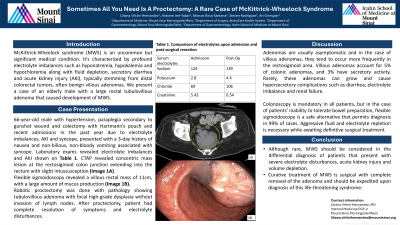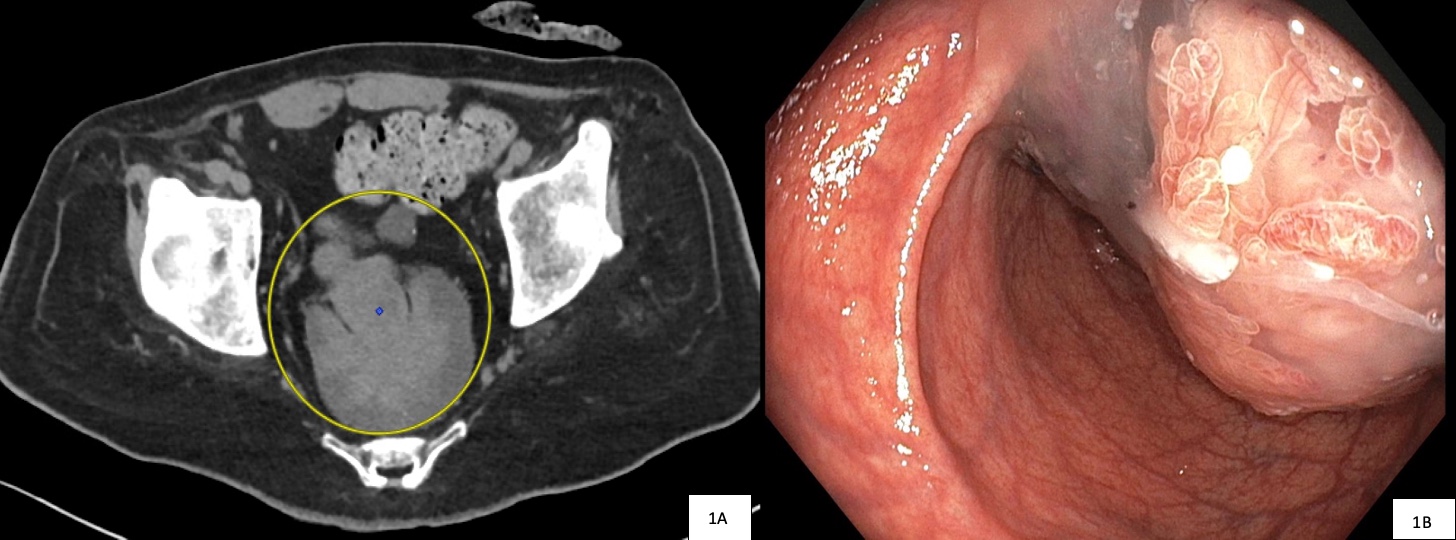Monday Poster Session
Category: Colon
P2050 - Sometimes All You Need Is A Proctectomy: A Rare Case of McKittrick-Wheelock Syndrome
Monday, October 28, 2024
10:30 AM - 4:00 PM ET
Location: Exhibit Hall E

Has Audio

Liliana Vittini-Hernandez, MD
Icahn School of Medicine at Mount Sinai Morningside/West
New York, NY
Presenting Author(s)
Liliana Vittini-Hernandez, MD1, Antoine Jeri-Yabar, MD2, Marcos Rosa-Santana, MD3, Steven Rodriguez, MD1, Ari Grinspan, MD4
1Icahn School of Medicine at Mount Sinai Morningside/West, New York, NY; 2Icahn School of Medicine at Mount Sinai Morningside/West, Manhattan, NY; 3BronxCare Health System, New York, NY; 4Icahn School of Medicine at Mount Sinai, New York, NY
Introduction: McKittrick-Wheelock syndrome (MWS) is an uncommon but significant medical condition. It's characterized by profound electrolyte imbalances such as hyponatremia, hypokalemia and hypochloremia along with fluid depletion, secretory diarrhea and acute kidney injury (AKI), typically stemming from distal colorectal tumors, often benign villous adenomas. We present a case of an elderly male with a large rectal tubulovillous adenoma that caused development of MWS.
Case Description/Methods: A 66-year-old male with hypertension, paraplegia secondary to gunshot wound and colectomy with Hartmann's pouch and recent admissions in the past year due to electrolyte imbalances, AKI and syncope, presented with a 3-day history of nausea and non-bilious, non-bloody vomiting associated with syncope. Laboratory exams revealed electrolyte imbalances and AKI shown on Table 1. CTAP revealed concentric mass lesion at the rectosigmoid colon junction extending into the rectum with slight intussusception (Image 1A).
Flexible sigmoidoscopy revealed a villous rectal mass of 11cm, with a large amount of mucus production
(Image 1B). Robotic proctectomy was done with pathology showing tubulovilloous adenoma with focal high-grade dysplasia without invasion of lymph nodes. After proctectomy, patient had complete resolution of symptoms and electrolyte disturbances.
Discussion: Adenomas are usually asymptomatic and in the case of villous adenomas, they tend to occur more frequently in the rectosigmoid area. Villous adenomas account for 5% of colonic adenomas, and 3% have secretory activity. Rarely, these adenomas can grow and cause hypersecretory complications such as diarrhea, electrolyte imbalance and renal failure.
Colonoscopy is mandatory in all patients, but in the case of patients' inability to tolerate bowel preparation, flexible sigmoidoscopy is a safe alternative that permits diagnosis in 99% of cases. Aggressive fluid and electrolyte repletion is necessary while awaiting definitive surgical treatment.
In conclusion, although rare, MWS should be considered in the differential diagnosis of patients that present with severe electrolyte disturbances, AKI and volume depletion. Curative treatment of MWS is surgical, with complete removal of the adenoma, and should be expedited upon diagnosis of this life-threatening syndrome.

Note: The table for this abstract can be viewed in the ePoster Gallery section of the ACG 2024 ePoster Site or in The American Journal of Gastroenterology's abstract supplement issue, both of which will be available starting October 27, 2024.
Disclosures:
Liliana Vittini-Hernandez, MD1, Antoine Jeri-Yabar, MD2, Marcos Rosa-Santana, MD3, Steven Rodriguez, MD1, Ari Grinspan, MD4. P2050 - Sometimes All You Need Is A Proctectomy: A Rare Case of McKittrick-Wheelock Syndrome, ACG 2024 Annual Scientific Meeting Abstracts. Philadelphia, PA: American College of Gastroenterology.
1Icahn School of Medicine at Mount Sinai Morningside/West, New York, NY; 2Icahn School of Medicine at Mount Sinai Morningside/West, Manhattan, NY; 3BronxCare Health System, New York, NY; 4Icahn School of Medicine at Mount Sinai, New York, NY
Introduction: McKittrick-Wheelock syndrome (MWS) is an uncommon but significant medical condition. It's characterized by profound electrolyte imbalances such as hyponatremia, hypokalemia and hypochloremia along with fluid depletion, secretory diarrhea and acute kidney injury (AKI), typically stemming from distal colorectal tumors, often benign villous adenomas. We present a case of an elderly male with a large rectal tubulovillous adenoma that caused development of MWS.
Case Description/Methods: A 66-year-old male with hypertension, paraplegia secondary to gunshot wound and colectomy with Hartmann's pouch and recent admissions in the past year due to electrolyte imbalances, AKI and syncope, presented with a 3-day history of nausea and non-bilious, non-bloody vomiting associated with syncope. Laboratory exams revealed electrolyte imbalances and AKI shown on Table 1. CTAP revealed concentric mass lesion at the rectosigmoid colon junction extending into the rectum with slight intussusception (Image 1A).
Flexible sigmoidoscopy revealed a villous rectal mass of 11cm, with a large amount of mucus production
(Image 1B). Robotic proctectomy was done with pathology showing tubulovilloous adenoma with focal high-grade dysplasia without invasion of lymph nodes. After proctectomy, patient had complete resolution of symptoms and electrolyte disturbances.
Discussion: Adenomas are usually asymptomatic and in the case of villous adenomas, they tend to occur more frequently in the rectosigmoid area. Villous adenomas account for 5% of colonic adenomas, and 3% have secretory activity. Rarely, these adenomas can grow and cause hypersecretory complications such as diarrhea, electrolyte imbalance and renal failure.
Colonoscopy is mandatory in all patients, but in the case of patients' inability to tolerate bowel preparation, flexible sigmoidoscopy is a safe alternative that permits diagnosis in 99% of cases. Aggressive fluid and electrolyte repletion is necessary while awaiting definitive surgical treatment.
In conclusion, although rare, MWS should be considered in the differential diagnosis of patients that present with severe electrolyte disturbances, AKI and volume depletion. Curative treatment of MWS is surgical, with complete removal of the adenoma, and should be expedited upon diagnosis of this life-threatening syndrome.

Figure: Image 1A: Concentric mass lesion at the rectosigmoid junction on CTAP; Image 1B: Tubulovillous adenoma on flexible sigmoidoscopy
Note: The table for this abstract can be viewed in the ePoster Gallery section of the ACG 2024 ePoster Site or in The American Journal of Gastroenterology's abstract supplement issue, both of which will be available starting October 27, 2024.
Disclosures:
Liliana Vittini-Hernandez indicated no relevant financial relationships.
Antoine Jeri-Yabar indicated no relevant financial relationships.
Marcos Rosa-Santana indicated no relevant financial relationships.
Steven Rodriguez indicated no relevant financial relationships.
Ari Grinspan indicated no relevant financial relationships.
Liliana Vittini-Hernandez, MD1, Antoine Jeri-Yabar, MD2, Marcos Rosa-Santana, MD3, Steven Rodriguez, MD1, Ari Grinspan, MD4. P2050 - Sometimes All You Need Is A Proctectomy: A Rare Case of McKittrick-Wheelock Syndrome, ACG 2024 Annual Scientific Meeting Abstracts. Philadelphia, PA: American College of Gastroenterology.
